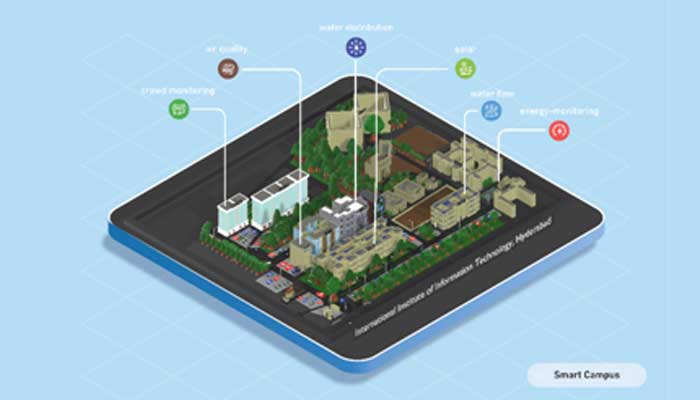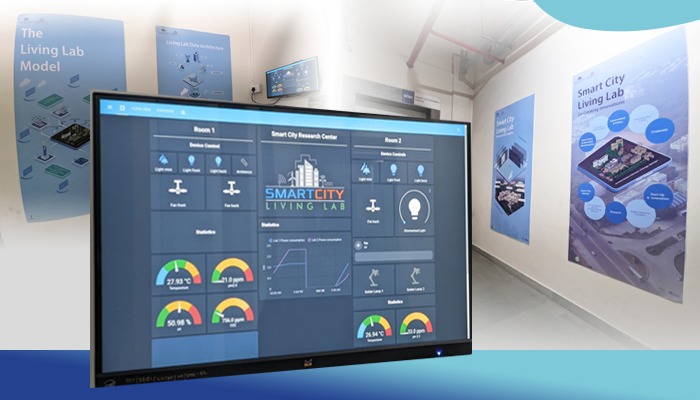India’s first Living Lab is the sprawling 66-acre IIIT Hyderabad campus, where the entire community is a proud stake-holder of the live test-bed for research in smart cities, in a bottom-up approach to IoT-enabled solutions in key verticals. We deconstruct the success story.
Everyone has a lockdown story but this one takes the cake
At the height of Lockdown 3.0 in August 2020, four IIITH engineering students – Ayu Pamar, Usha, Ganesh, Suhas and Sam Babu a Ph.D scholar were locked on campus with their professors, building sensors in the quiet anonymity of the SPCRC lab with remote guidance from Anuradha Vattem, Lead Architect. None were allowed inside the grounds and the skeletal staff could move in, only after a 14-day quarantine. This was the background to the genesis of IIITH’s Living Labs, that was founded in the midst of a pandemic.
The Smart City Living Lab was a most desirable outcome from a providential meeting between Dr. A. K Garg, Prof. Ramesh Loganathan, MeitY and European Business and Technology Centre (EBTC). “I thought I was just indulging Dr. Garg but there was a follow up meeting and the financial proposal for the Living Labs was passed within a few weeks”, states Prof Loganathan.
It all began in early 2019, at IIITH’s first workshop on Embedded Systems, when Prof. Vishal Garg, Prof. Sachin Chaudhari and Prof. Aftab Hussain worked with their students to build IoT boards and experimented with using the campus as a live testbed. They had deployed their first pollution node and had built a web board model to measure pollution levels.
Later that year, a IIITH team would visit France to explore collaboration opportunities with French universities, start-ups and the government. They were already working with LAAS-CNRS, Toulouse and using their oneM2M version which was available on open source. While touring Amsterdam’s Living lab at the Johan Cruyff Arena, “we realized that we are also working with similar IoT products and have scope to build our own living lab on campus, with sensors deployed for energy, power, water and pollution monitoring”, observes Prof. Loganathan, IITH’s Professor of Practice & Co-innovations.
A MeitY collaboration
The Living Lab was set up on the IIIT Hyderabad campus with support from MeitY, Smart City Mission, EBTC and Government of Telangana in collaboration with Amsterdam Innovation Arena. In March 2020, the MoU was signed, but within days the pandemic would shut down the campus and preliminary work would commence in virtual mode. Intel, Silicon labs and Saint-Gobain would come on board as strategic collaborators with IUDX (India Urban data exchange) as program partner.

The major pillars of IIITH’s Living Lab are the smart campus, research centers and the innovation incubator. The multi-disciplinary platform is a test bed for prototypes built out of research at the Center for IT in Building Sciences and allied Centers for Signal Processing, AI/ML and VLSI-embedded systems.
Building India’s first living lab smart campus
In May 2020, the Smart City Research Centre (SCRC) was launched, working temporarily out of the SPCRC Lab. Today, the Center has its own dedicated Research Labs and a Control Centre that monitors the large bank of sensors, controls and data infrastructure stretched across 66 acres with 2 million sq. ft. space, with 4000+ occupants and 250 startups in the pipeline. There are 22+ research centers with 6 directly related to Smart Cities, that take up projects immediately relevant to smart city use cases. The Institute hosts an Innovation Incubator for startups working on Smart City solutions as well as for tech companies seeking to validate their findings in the Living Lab.
The initial verticals identified were air quality/pollution, water quality, water flow and distribution, renewable energy (solar), smart spaces, weather monitoring, crowd monitoring and smart lampposts.

What lies behind the smart campus?
“Between December 2020 and June 2021, we had deployed sensors for water, smart spaces and air quality at different locations on campus to record data, updated on the dashboard every 10 minutes”, explains SCRC projects lead Anuradha Vattem who brings 25 years of industry expertise in hardware, software and firmware to her role. “I have done systems – from 1000 meters below the surface, all the way to satellite payload products and electronic warfare”, she laughs. Her mandate was to define and design the framework of the data model, deployment of the nodes, create a data storage and information model and guide the team to get things in place.
Live data is continuously streamed from 150 sensors to a dynamic dashboard at the SCRC Nodal Center via a series of communication networks. The 3D dashboard offers the user a summary view of the overall status of the campus and gives a feel about where exactly the nodes are placed. oneM2M is the middleware employed to categorize the captured raw data into containers, that are well described. The Center is experimenting with multiple communication modes like WiSUN, LoRaWAN, ESIM and 4G networks, with 5G on pipeline.
Dr. Sachin Chaudhari, the IoT expert oversees air quality and water quantity measurement. Visitors to IIITH are generally treated to the unusual sight of 2 pods in the SCRC parking space, one of Prof. Vishal’s ongoing IoT-enabled HVAC projects along with solar, weather and smart spaces. Dr. Aftab Hussain oversees the LoRaWAN devices along with domestic water metrics and Dr. Deepak Gangadharan takes care of drinking water quality metrics and the Data lake and IUDX interface implementation. Today, there are 6 cameras deployed on campus for crowd monitoring, overseen by Prakash Yalla – Head of the Products Lab, with software that he had successfully employed at the Godavari Pushkaralu.
The nodal center with all its gadgetry, measures internal air quality and controls lights/fans within the Lab and monitors connected devices across the campus, churning out analytics for insights. Apart from motion activated sensors in the hallways, SCRC has an ongoing occupancy experiment, with a variety of nodes deployed in the Nodal center, including thermal, grid-eye sensors, ultra-sonic, Wi-Fi sensor and infrared sensors to detect motion/occupancy.

An efficient microcosmic model for India’s smart cities
This is India’s first smart city living lab on a campus, observes Prof. Loganathan. “The smart cities mission is 5 years old and with our Living Lab experience, we hope to pilot our model to other smart cities in India, to update or lead them to become self-sufficient. By way of roundtables, conversations and multiway collaborations, we hope to connect people because in many places there are no platforms to come together and exchange information”. SCRC currently has 8-10 projects in the pipeline. The Telangana government is in talks with IIIT Hyderabad to set up a Water Center of Excellence and a technology office for the water supply board, to try out different technologies, meters and communication.
“The concept of the Living lab is only the starting point”, he predicts. The idea is that the overall campus infrastructure will be a melting pot for government, corporate partners, smart city solutions providers, NGOs, policymakers, research labs and startups to discuss new collaborations and for policy formulations.



Next post